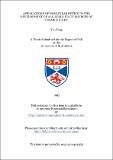Applications of nonlinear optics to the development of all-solid-state sources of tunable light.
Abstract
This thesis describes the development of singly-resonant optical parametric oscillators (OPOs) based on the nonlinear material KTP (potassium titanyl phosphate), and used to provide tunable light in the infrared, with low oscillation threshold and high efficiency. Further, the generation of tunable red light by the frequency mixing of the signal wave from the OPO with the pump wave in a non-critical temperature phase-matched lithium triborate crystal (LBO) is reported. We believe this is the first demonstration of such an application of LBO. Two diode-pumped solid-state lasers were used as the pump sources. One was an electro-optically Q-switched Nd:YLF laser which provided high peak power (~600 kW) pulses; and the other one was an acousto-optically Q-switched slab-geometry Nd:YLF laser which provided high repetition rate (1~10 kHz) a.nd low peak power(<30 kW) pulses. A second version of the acousto-optically Q-switched slab-geometry Nd:YLF laser was designed and constructed with improvements in the pump module and cooling system so as to be much more compact and easier to control. In the first stage of this work, two theoretical models were constructed. One was a model for pump threshold of singly-resonant OPOs for the case of focused Gaussian beams, and was based on Guha's theory. The second one was a model for conversion efficiency of singly-resonant OPOs, for the case of plane waves with pump depletion, and was derived from the coupled wave equations. In the second stage of this work, the effects of beam focusing and Poynting vector walk-off on pump threshold and conversion efficiency for OPOs were extensively studied theoretically and experimentally. Experimental results were found to be in good agreement with theory. The high pump threshold of the critically phase-matched KTP OPO led to several other pump configurations being considered, including intracavity OPOs, cylindrical focusing, and donble-pass of the pump. As a result of the KTP OPO study, very low pump thresholds were achieved in both non-critical phase-matched (NCPM) and critical phase-matched (CPM) KTP OPOs by using long crystal in both intracavity OPOs and the double-pass-pump configuration. Maximum external conversion efficiency from pump to signal was demonstrated to be 37% for the NCPM OPO and 40% for the CPM OPO. The signal wavelength tuning ranges were observed to be 1.54-1.56 mum from the NCPM KTP OPO, and 1.58-1.8 mum from the CPM KTP OPO. In the final stage of this work, the temperature phase-matching properties of LBO were investigated with the use of our measured thermo-optical coefficients of LBO. A particularly interesting result of the investigation is the possibility of sum-frequency generation in non-critically phase-matched LBO with temperature tuning giving considerable wavelength ranges for both the type I and type II geometries. Experimentally, we demonstrated tunalile red light generation by sum-frequency mixing of the 1 mum pump wave and the signal wave of the KTP OPO with an over all conversion efficiency of more than 13%. The wavelength tuning range was observed to 0.62-0.65 mum. The effects of beam focusing on the conversion efficiency for sum-frequency generation were analysed theoretically, and several opportunities for further improvement were shown clearly from this analysis.
Type
Thesis, PhD Doctor of Philosophy
Collections
Items in the St Andrews Research Repository are protected by copyright, with all rights reserved, unless otherwise indicated.

